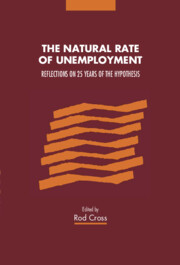Book contents
- Frontmatter
- Contents
- List of Contributors
- Preface
- 1 Introduction
- Part I The theoretical framework
- 2 The origins and further development of the natural rate of unemployment
- 3 The natural rate as new classical macroeconomics
- 4 Theoretical reflections on the ‘natural rate of unemployment‘
- 5 Of coconuts, decomposition, and a jackass: the genealogy of the natural rate
- Part II Adjustment, ranges of equilibria and hysteresis
- Part III Empirical tests and macro models
- Part IV Political economy
- Index
4 - Theoretical reflections on the ‘natural rate of unemployment‘
Published online by Cambridge University Press: 03 May 2011
- Frontmatter
- Contents
- List of Contributors
- Preface
- 1 Introduction
- Part I The theoretical framework
- 2 The origins and further development of the natural rate of unemployment
- 3 The natural rate as new classical macroeconomics
- 4 Theoretical reflections on the ‘natural rate of unemployment‘
- 5 Of coconuts, decomposition, and a jackass: the genealogy of the natural rate
- Part II Adjustment, ranges of equilibria and hysteresis
- Part III Empirical tests and macro models
- Part IV Political economy
- Index
Summary
Introduction
Phillips (1958) started it with what he claimed was an inverse relation, derived from historical data, between unemployment and the rate of change in money wages. This suggested that the price of lower unemployment was inflation – the famous ‘trade-off’. The paper gave rise to some rudimentary theorising. It soon dawned on those interested that workers were concerned with wages in terms of wage goods and employers in wages in terms of product prices. Since the theory quickly became a branch of macroeconomics and since as a first step it was easier to deal with a closed economy and to neglect taxes, the distinction between the two wage deflators was ignored and one simply considered ‘real’ wages. Thus the real Phillips curve was born, that is, a relation between unemployment and real wage was the object of enquiry.
All of this coincided with the counter-revolution in macroeconomics. For present purposes this entailed the hypothesis that labour is at all times on its supply curve – ‘involuntary’ unemployment was impossible. This was treated as an axiom. A distinction, however, was made between the long run and short run. In both ‘runs’, again axiomatically, markets clear but in the short run expectations may be falsified while in the long run they are correct. (This must be understood in the sense of expectations being ‘rational’ or not.) The natural rate of unemployment and its twin the ‘non-accelerating inflation rate of unemployment (NAIRU)’ refer to the long run.
- Type
- Chapter
- Information
- The Natural Rate of UnemploymentReflections on 25 Years of the Hypothesis, pp. 43 - 56Publisher: Cambridge University PressPrint publication year: 1995
- 4
- Cited by



